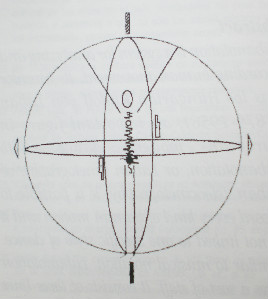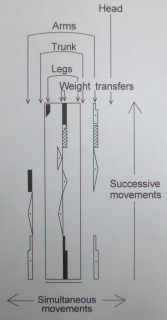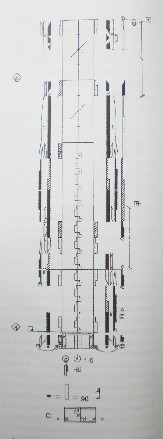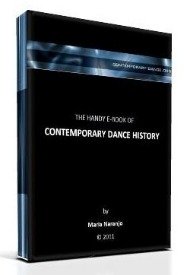KINETOGRAPHY LABAN , also known as LABANOTATION.
Kinetography Laban or Labanotation (1) is one of the amazing European inventions from the XX century. Due to its rarity and originality, it is still, after almost one century of its first publication, the object of curious looks, questionings and even reactions of distrust and rejection.
Rudolph Laban (1879-1958) was a Hungarian dancer that dedicated his life to the practice, teaching and theory of dance.
He invented labanotation, a system for analyzing and recording movement that should, according to his own words “contribute with the dancers freedom, concerning the different traditions” (2) of danced movement that were practiced till the time.
With the intention of elaborating a tool that would make possible the visualization or imagination, as well as the practice of a larger spectrum of gestures than the “fixed figures of ballet” (3), Laban determined a way to describe the surrounding space of human body in motion, from which new movement combinations could be discovered.
How does Labanotation work?

The basic reference of labanotation is what he called the kinesphere (4).
This virtual space around the body, crossed by a vertical axe that corresponds to the direction of gravity, serves to first establish the directions in space towards which the different parts of the body will move.
Each direction has a corresponding sign that represents it.

Directions in space identified like this can be organized as in a musical score, over a kinetogram or staff. It is made out of three parallel, vertical lines that are read from the bottom to the top and whose continuity represents the temporal dimension of movement.
They allow the organization of the direction signs by the correspondence of each one of the columns with the different parts of the body.
The horizontal positioning of the signs (one beside another) corresponds to simultaneous movements (an arm and a leg at the same time, for example). The vertical positioning of signs (one after the other) corresponds to the successive movements (first the arm, then the leg and so forth).
This particular look proposed by Laban, where a coincidence between the “subjective space of the dancer and the objective space of the kinesphere” (5) is simulated, allows us to approach the transcription of dance, thanks to a description of the space crossed by the moving body.
Labanotation doesn’t make reference to codified dance steps or style characterizations. Movement is always considered in spatial terms like up, down, to the side, backwards, etc.
This makes of labanotation a tool that is adaptable to other type of movement analysis outside the field of dance, like sports, work and others.

(To the right: labanotation fragment of the choreography “La Guaneña - Bambuco Nariñense” from the Corporación Ballet Folclórico de Antioquia. Dance notation: María del Pilar Naranjo. Under the direction of professor Noëlle Simonet (C.N.S.M.D.P.), 2004.)
Although one of the goals of inventing labanotation was to broaden the frontiers and freedom of danced movement, he recognized the possibility of using the system as a notation tool to preserve dance (the same way music does with its own written language).
The idea of preserving a memory of dance has been more or less well received in the world, with apparently a lot more success in the United States than in Europe.
The I.C.K.L. (International Council of Kinetography Laban) currently holds a collection of dance scores of more than 6000 documents, which testifies the faith in the production of a choreographic patrimony by the dance writers’ community.
Nevertheless, as dance has been transmitted mainly by oral tradition till the XX century, the appearance of labanotation as a revolutionary possibility provokes lot of questionings. ¿What kinds of documents are those scores? ¿What is the perspective or look that constructs them? ¿How precise, or how much reading freedom, do they propose? ¿What is their content, really?
It should be enough to consider the experience music has had with its own writing method to know that notating systems of phenomena like sound or movement are everything but an exact or rigid representation of nature. They are references over which the artists recreate, knowing that the original source from which the score has been written belongs to another time end space, another context and individuals; to sum up, to a total reality that can not be reduced to the simplicity of some signs written on a paper.
Not only that reality escapes partially to the writer, but it suffers the influence of his singularity: the look that chooses what will be written and the way of expressing it, his attention, determined by a personal story that sees some things and omits others, his subjective judgment or even his personal aesthetic opinions.
To that, we can sum the own limits of any language (in this case those of labanotation), with its inherent ambiguity and its constantly evolving state.
The pretention of an exact record of a dance, but mostly of what happens in the body that dances, does not belong to the practice of kinetography Laban. Such aim would not only fail to recognize the essential nature of dance (constant change), but mostly the complexity of its support of existence: human body: subjective, unique and almost indecipherable.
Practicing kinetography Laban is really an exercise of knowledge of a possible imaginary of the moving body (its surrounding space and its relation with body parts), to draw the specific dance from there.
¿Isn’t this finally what we do as dancers when we decide to learn a specific dance ‘technique’? This is just another way to do it.
There’s also a pleasure and a physical effect in the action of constructing those imaginary movement images and approaching this new body woven on space. With other methods we experience bodies that highlight their bones to understand themselves, others that are organized by its internal organs; there’s also the body that only feels its muscles or the one in the visual image of the mirror, almost empty….
Kinetography Laban’s body is another one, between the infinite of possible bodies: another painting, another feeling, another mental projection of itself, a piece of art.
Now, Labanotation does not presuppose any postural organization. It just describes (in a very complete and coherent way that allows to read dance phrasing) the traces of a geometric imaginary that has to be interpreted, incorporated and left to become mature. It is then that dance emerges: the one of the living and sensible body of experience.
That might be the feature that makes kinetography Laban a unique studying tool. A dance score is, regardless of its writer’s look, an impersonal document, without postural background, muscular memory, affections or magnetisms. This, instead of replacing the presence of a teacher, complements it. It creates the possibility of a studying time for the dancer in which body needs in its current state are respected. Personal time of introspection, during the process of observing own sensations or incorporating information, is free.
Also, dance writing or reading can truly be like a game: to enjoy contemplating a moving body and the definition of the paths that it draws in space; to glimpse through the imaginary lines that it leaves behind, codify them and set them together…
It is also to take pleasure with the beauty of the signs and their possible combinations, letting yourself go by the images they suggest.
During the reading, to dig the score and find the dance buried between your look and the text, then see how it comes to life magically; to discover the sense of a movement hidden between the signs and feeling a human intention that comes from that unknown universe (where the score comes from); to recreate or make dances emerge, leaning on another’s imagination... .
Dancing, just dancing this inexact proposal that comes from far away but that gives us a starting point to abandon ourselves to movement.
You can adopt several attitudes in reading a score: stay as close as possible to what signs say (a particular dance quality will result from that effort) or reading what one wants to read and not what is exactly written (what some people call reading automatisms), and stay comfortably in the moving habits that belong to us.
A dance can be written with meticulous intentions, taking entire months to analyze it, or can be just sketched quickly during a working day.
You can even move away from the logic of the system, recreating own writing strategies, according to the interest that motivates the writing and the respect that you care for its origins. It is a tool. It is unavoidable that each person decides upon the possible ways to use it.
Though, writing and reading “to seize the life” (6) of dance, as well as translating it in a fair way, is an art. “So it is a creative process” (7).
My personal experience has shown me that kinetography Laban, Labanotation or Teleokinetography (8) Laban, other than being amusing, it is an experience of knowledge of a unique richness and interest. It has broadened my consciousness of space, my relation to it, and it has even offered me technical alternatives to understand my body.
To those who are still asking themselves what the use of kynetography might be, I’d say you could ask yourselves what written language and its evolution means for humanity today. I bet Cro-Magnons didn’t imagine the reality in which we live nowadays…
1. These two names correspond to the European and North American uses respectively.
2. Fragment from : Tanzkomposition und Schrifttanz. In : Schrifttanz, Vol 1.,Vienna, 1928 (chosen and translated to english by V. Preston Dunlop et S. Hausen in « Schrifttanz, a view of german Dance in the Weimar Republic », Dance Books, London, 1990.
3. Ibid.
4. Kinesphere: maximum space achieved by the standing human body without elevating the feet.
5. Corin, Florence. Kuypers, Patricia. En : Nouvelles de Danse. Espace Dynamique. Contredanse, Bruxelles, 2003 p. 10. Translated to English by me.
6. Perlov, Noémie. “Écriture Benesh. La choréologie, un procédé créatif.” In: Marsyas N° 6, juin 1988. p.10 (translated to French by Joëlle Naim).
7. Ibid. p. 8
8. Name suggested by professor S. Hecquet of the University of Paris VIII, with the goal of making the nature of notation clearer. Teleo: goal, cineto: movement, graphos: drawing.
One last word…
Remember that I am a certified choreologist from the National Conservatory for Music and Dance of Paris. If you ever want to learn how to write dance or have any questions about Labanotation… I’m a ‘best of the breed’ resource to go and ask!
Related readings:
Dance notation and how to write it?
Use of Simplified Labanotation
Español. La cinetografía Laban o Labanotación
Return from Labanotation to Dance Theory
Return to Contemporary Dance Home Page
The handy e-book of CONTEMPORARY DANCE HISTORY:
The Dance Thinker is our occasional E-zine. Fill in the form below to receive it for free and join us.
Read:
"The Dance Thinker"
BACK ISSUES
Post contemporary dance announcements (workshops, auditions, performances, meetings and important news... it is free.)



